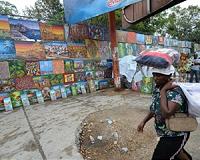| . |  |
. |
Santiago, Chile (UPI) Mar 22, 2009 Electricity power supply in Chile remains sporadically unstable in regions that were hit most directly in the Feb. 27 earthquake. One of the suppliers, AES Gener Corp., said 95 percent of its installed capacity in Chile was operational though some areas needed further work on the systems to restore them to full service. The National Emergency Office said that most the power supply was restored after the blackout last week that resulted from a failure of the grid. The blackout affected Santiago and other cities across Chile. Officials said the service was likely to remain unstable in some parts while experts continued work on identifying and rectifying problems with the supply. A spokesman urged Chileans to remain prepared for interruptions and warned that a blackout could always happen amid uncertain conditions of the operating system. Energy Minister Ricardo Raineri warned normalization of the power supply system could take up to six months due to the devastation caused by the 8.8-magnitude earthquake. Raineri said blackouts could recur without warning but called on citizens to help authorities restore the situation to normal through calm coordination of relief and reconstruction programs. AES Gener, a 71 percent owned subsidiary of AES Corporation, said it has inspected all facilities for damage from the earthquake and repairs have been largely completed. As of March 22, 95 percent, or 2,975 megawatts out of 3,129 megawatts of AES Gener's total capacity serving the Chilean market is operational, the company said. "At any given time, certain facilities are not operational due to dispatch priorities or regularly scheduled maintenance," it added. AES Gener's construction sites, the 518-megawatt Angamos plant, 152-megawatt Guacolda 4 and 270-megawatt Campiche facilities, weren't affected by the earthquake or subsequent aftershocks, AES Gener said. Chilean President Sebastian Pinera is considering a selective tax hike to raise cash for a $30 billion reconstruction program. Pinera took office less than two weeks after the temblor struck. Last week he announced an emergency program to create 60,000 jobs in the stricken areas as part of an overall effort to restore basic amenities, education and healthcare. More than 200,000 homes were destroyed by the earthquake and resulting tsunami and more than 2,750 schools and 35 hospitals have had to be abandoned until they are rebuilt. The government's plan is to raise the royalty tax on the country's mining sector, Chile's most important earner mainly through copper exports. But the plan is controversial and is likely to be opposed by the powerful mining industry, which also faces plans for a partial privatization.
Share This Article With Planet Earth
Related Links Bringing Order To A World Of Disasters A world of storm and tempest When the Earth Quakes
 Haiti's cultural heritage faces quake extinction
Haiti's cultural heritage faces quake extinctionPort-Au-Prince (AFP) March 21, 2010 Brilliant colors shine through the ruins of the Cathedrale de la Sainte-Trinite, fragments of wonderful murals that were the climax of Haiti's artistic explosion 60 years ago. For gallery owner Toni Monnin, the loss of irreplaceable frescoes by the first generation of Haitian master painters is the most powerful symbol of the cultural devastation wrought by the January 12 earthquake. "Th ... read more |
|
| The content herein, unless otherwise known to be public domain, are Copyright 1995-2010 - SpaceDaily. AFP and UPI Wire Stories are copyright Agence France-Presse and United Press International. ESA Portal Reports are copyright European Space Agency. All NASA sourced material is public domain. Additional copyrights may apply in whole or part to other bona fide parties. Advertising does not imply endorsement,agreement or approval of any opinions, statements or information provided by SpaceDaily on any Web page published or hosted by SpaceDaily. Privacy Statement |